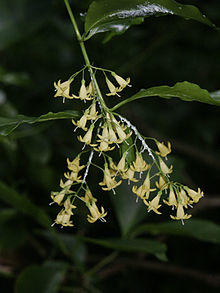| West Indian milkberry | |
|---|---|
 | |
| Scientific classification | |
| Kingdom: | |
| (unranked): | |
| (unranked): | |
| (unranked): | |
| Order: | |
| Family: | |
| Genus: | |
| Species: | C. alba |
| Binomial name | |
| Chiococca alba | |
| Synonyms | |
| Chiococca bermudiana S.Br.[2] Chiococca racemosa L. | |
Chiococca alba is a species of flowering plant in the coffee family (Rubiaceae) native to Florida and the extreme southern tip of Texas in the United States,[3] Bermuda,[2] Mexico, Central America, the Caribbean, the Galápagos, and tropical South America. Common names include David's milkberry, West Indian milkberry, cahinca[4] and West Indian snowberry.[5] The specific epithet, alba, means "white" in Latin and refers to the color of its fruits.[6]
Description
West Indian milkberry is an evergreen[4] woody vine or scrambling shrub that often grows on other vegetation and may reach a height of 6 m (20 ft).[5] The opposite, simple leaves are 5–11 cm (2.0–4.3 in) long and may be elliptic to ovate or broadly lanceolate in shape. Yellow, bell-shaped flowers up to 1 cm (0.39 in) in length appear throughout the year[7] on racemes or panicles of six of to eight.[8] The fruit is a white drupe 4–7 mm (0.16–0.28 in) in diameter[7] that generally contains two dark brown seeds.[5]
Taxonomy
Lonicera alba was described in 1753 by Carl Linnaeus.[9] It was moved to Chiococca in 1893 by A. S. Hitchcock,[1] and is considered the type species of that genus.[10] Stewardson Brown described the Bermuda population of the plant as a new species, C. bermudiana, in 1909 due to its lighter green and larger leaves, larger berries, and wider and longer pedicels. Many authorities consider C. bermudiana a synonym of C. alba.[2]
Uses
C. alba is sometimes cultivated as an ornamental for its dark green, evergreen foliage and white drupes. It is used in espalier and grown on trellises.[8] The roots have several uses in herbal medicine, including as a laxative, diuretic, emetic, and antidiarrhoeal.[5] The plant was sold commercially in Europe and the United States for those purposes at one time.[11]
References
- ^ a b c "Chiococca alba". Germplasm Resources Information Network (GRIN). Agricultural Research Service (ARS), United States Department of Agriculture (USDA). Retrieved 2010-04-19.
- ^ a b c Sarkis, Samia (December 2009). "Recovery plan for eight species of flowering plants, Carex bermudia, Peperomia septentrionalis, Phaseolus lignosus, Erigeron darrellianus, Galium bermudense, Hypericum hypericoides, Psychotria lingustrifolia, in Bermuda" (PDF). Department of Conservation, Bermuda: 4. Archived from the original (PDF) on 2011-07-06.
- ^ "David's Milkberry, Snowberry, Milkberry, David's Root, Perlilla, Canica, Cahinca, Cainea, Caninara, Aceitillo, Madreselva, Lagrimas de San Pedro, Lagrimas de Maria, Oreja de Raton, Suelda, Consuelda, Bejuco de Berac, Bejuco de Berraco, Xcanchac-che". Texas A&M University. Retrieved 2009-12-11.
- ^ a b "Chiococca alba (L.) A.S. Hitchc". Native Plant Information Network. Lady Bird Johnson Wildflower Center. Retrieved 2009-12-11.
- ^ a b c d "Chiococca alba (L.) A.S. Hitchc. West Indian snow-berry" (PDF). International Institute of Tropical Forestry. United States Forest Service. Retrieved 2009-12-11.
- ^ Hammer, Roger L. (2004). Florida Keys Wildflowers: A Field Guide to Wildflowers, Trees, Shrubs, and Woody Vines of the Florida Keys. Globe Pequot. p. 104. ISBN 978-0-7627-2569-4.
- ^ a b Nelson, Gil (1996). The Shrubs and Woody Vines of Florida: a Reference and Field Guide. Pineapple Press Inc. p. 297. ISBN 978-1-56164-110-9.
- ^ a b Gilman, Edward F. (October 1999). "Chiococca alba" (PDF). Cooperative Extension Service Institute of Food and Agricultural Sciences. University of Florida. Archived from the original (PDF) on January 16, 2009. Retrieved 2009-12-12.
- ^ "Lonicera alba". Germplasm Resources Information Network (GRIN). Agricultural Research Service (ARS), United States Department of Agriculture (USDA). Retrieved 2010-04-19.
- ^ "Chiococca P. Browne". TROPICOS. Missouri Botanical Garden. Retrieved 2009-12-11.
- ^ Austin, Daniel F. (2004). Florida Ethnobotany. CRC Press. pp. 200–202. ISBN 978-0-8493-2332-4.